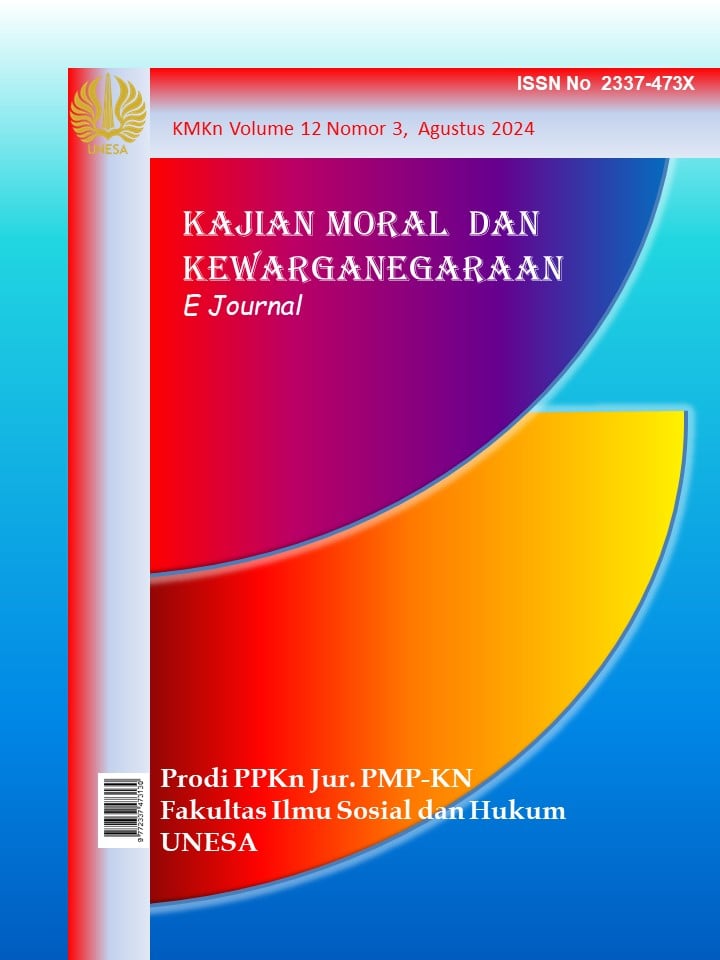MARGINALISASI DAN SUBORDINASI PADA PEREMPUAN PEKERJA INDUSTRI KIMIA DI KECAMATAN KRIAN
DOI:
https://doi.org/10.26740/kmkn.v12n3.p419-428Keywords:
Budaya Patriarki, Marginalisasi, Subordinasi, Pekerja PerempuanAbstract
Patriarchal culture still developing in various aspects of life, one of which is the aspect of work. In terms of work, it is not spared from the influence of patriarchal culture, as happened to women workers in the chemical industry "X" in Krian District who experienced marginalization of female workers in industry "X" in the form of limited job opportunities, then subordination in the form of unavailability of career paths for female workers. Therefore, it is necessary to know what causes women workers to receive injustice, as well as the response of women workers to these injustices. The purpose of this study is to analyze the causes of marginalization and subordination in women workers and reveal the responses taken by women workers when experiencing marginalization and subordination. The theory used is Naomi Wolf's Liberal Feminist Theory, this theory views that women have the same position as men. The method used is an exploratory qualitative method with a narrative study approach collecting data through interviews and observations. The results of this study explain that the causes of marginalization and subordination are external and internal factors. The external causes of marginalization are the patriarchal culture that is still inherent in society, the stereotyping of women workers who are considered weak, as well as the poverty and powerlessness of working women. Then the external factors that cause subordination are social stigma that considers women weak, limited access for female workers to get career paths. Furthermore, the internal factors that are the cause are the patriarchal values and the belief of women workers in gender roles that have been shaped by the social environment and society. Marginalization and subordination of workers will continue if women workers are still invented by the patriarchal values that exist in society.
Downloads
References
Afandi, A. (2019). Bentuk-bentuk perilaku bias gender. Journal of Gender and Children Studies, 1(1). 1-2
Alfian Rokhmansyah (2016). Pengantar Gender dan Feminisme: Pemahaman Awal Kritik Sastra Femiinis. Yogyakarta: Garudhawaca.
Al Insani, Y. F., & Jatiningsih, O. (2021). Perjuangan Legislator Perempuan Dalam Melawan Ketidakadilan Gender di DPRD Kabupaten Lamongan. Journal of Civics and Moral Studies, 6(2), 80-97.
Andriani, L., & Phahlevy, R. R. (2022). Legal Protection of the Rights of Women Workers in Sidoarjo Regency. Indonesian Journal of Law and Economics Review, 16, 10-21070.
Badan Pusat Statistik, 2023. Tingkat Partisipasi Angkatan Kerja Menurut Jenis Kelamin 2019-2023. (https://www.bps.go.id/id/statistics-table/2/MjIwMCMy/tingkat-partisipasi-angkatan-kerja-menurut-jenis-kelamin.html diakses : 28 Mei 2024)
Badan Pusat Statistik Provinsi Jawa Timur. 2022. Indeks Ketimpangan Gender (IKG) 2020 - 2022. (https://jatim.bps.go.id/indicator/40/607/1/indeks-ketimpangan-gender-ikg-.html, diakses : 17 Januari 2024)..
Iftitah, A., Puspitasari Romei, N., Yulianti, N., Putra, M. T. P., & Kunarso. (2023). Kesetaraan Gender Dalam Hukum Ketenagakerjaan. Jurnal Ilmu Hukum Dan Administrasi Negara, 1(2).
Karwati, L. (2021). MENOLAK SUBORDINASI GENDER BERDASARKAN PENTINGNYA PERAN PEREMPUAN DALAM PEMBANGUNAN NASIONAL MENJELANG BONUS DEMOGRAFI 2035. Jendela PLS, 5(2). https://doi.org/10.37058/jpls.v5i2.2713
Maulida, B., & Farisandy, E. D. (2022). Marginalisasi, Bentuk Diskriminasi Terhadap Perempuan. Buletin KPIN, 8(10).
Maryam, R. (2018). Menerjemahkan Konvensi Penghapusan Segala Bentuk Diskriminasi terhadap Perempuan (CEDAW) Ke Dalam Peraturan Perundang-Undangan (Translation of Convention On The Elimination of All Forms of Discrimination Against Women (CEDAW) Into The Regulation of Legislation). Jurnal Legislasi Indonesia, 9(1), 99-118.
Maryam, St. 2020. Dinamika Sosial Ekonomi Partisipasi Kerja Perempuan Menikah. Yogyakarta : Bintang Pustaka Madani.
Nazir, M. (2015). Pendekatan dan Jenis Penelitian. Jakarta: Rhineka Cipta.
Nuraeni, Y., & Suryono, I. L. (2021). Analisis Kesetaraan Gender dalam Bidang Ketenagakerjaan Di Indonesia. Nakhoda: Jurnal Ilmu Pemerintahan, 20(1), 68-79.
Rijali, Ahmad. 2018. Analisis Data Kualitatif. Jurnal Alhadharah. Vol.17,No. 33:91-94
Rosyana, M., & Jatiningsih, O. (2023). Peran Sekolah Perempuan dalam Mereduksi Budaya Patriarki pada Keluarga Desa Gogodeso Kecamatan Kanigoro Kabupaten Blitar. Jurnal Pendidikan Tambusai, 7(2), 10301-10309.
Sarina, M. R., & Ahmad, M. R. S. (2021). Diskriminasi Gender terhadap Perempuan Pekerja Di Kawasan Industri Makassar. Pinisi Journal of Sociology Education Review, 1(2), 64-71.
Setyawan, B. (2020). Patriarki Sebagai Akar Diskriminasi Gender di Sri Lanka. Resolusi: Jurnal Sosial Politik, 3(1), 1-14.
Shaleh, A. I., & Nasution, R. (2020). Perlindungan Hukum Tenaga Kerja Migran Indonesia Di Arab Saudi Sebagai Negara Non Internasional Convention On the Protection of The Rights of All Migrant Wokers and Members of Their Families. Jurnal Yustisiabel, 4(1), 27-39.
Shaleh, A. I., Pertiwi, D. A. A., & Shalihah, F. (2022). Kendala Perlindungan Hukum terhadap Hak Pekerja Perempuan: Tinjauan Convention On The Elimination of All Forms of Discrimination Againts Women (CEDAW). Ad-Dariyah: Jurnal Dialektika, Sosial dan Budaya, 3(2), 48-56.
Sugiyono. (2011). Metode Penelitian Kuantitatif, Kualitatif dan R&D. Bandung: Alfabeta.
Tong, R., & Botts, T. F. (2009). Feminist thought: A more comprehensive introduction. Routledge.
Wikipedia. 2022. Industri kimia. (https://id.wikipedia.org/wiki/Industri_kimia, diakses : 10 feberuati 2024).
Wolf, N. (2013). Fire with fire: New female power and how it will change the twenty-first century. Random House.
Wollstonecraft, M. (1992). A Vindication of the Rights of Woman. 1792. The Works of Mary Wollstonecraft, 5, 217.
Downloads
Published
How to Cite
Issue
Section
 Abstract views: 413
,
Abstract views: 413
, PDF Downloads: 231
PDF Downloads: 231





